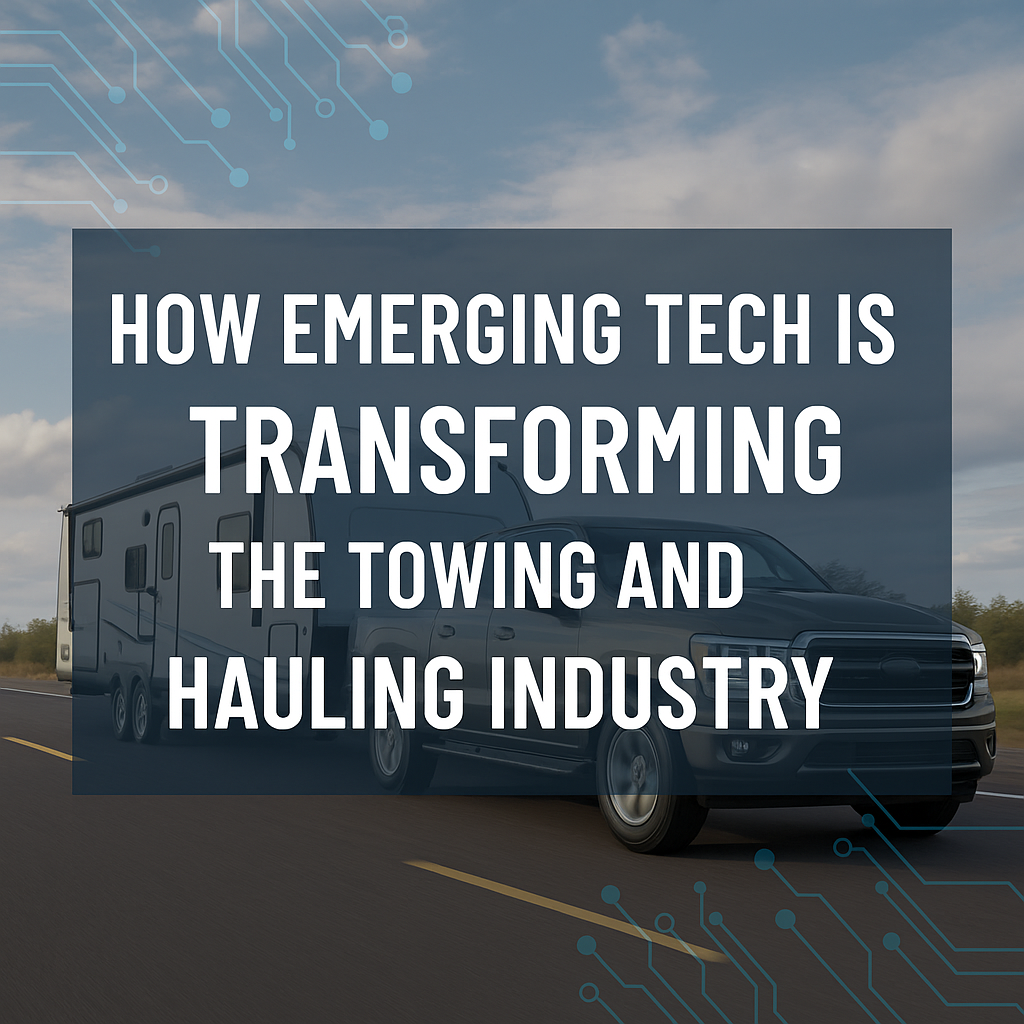Towing and hauling vehicles have long been a vital part of transportation, logistics, and outdoor recreation.
Whether you’re towing a camper trailer through the Rockies or hauling tools to a remote job site, understanding tow capacity and safety is essential.
But there’s a shift happening—emerging technologies are revolutionizing how we approach towing, making it more efficient, safer, and smarter.
How Emerging Tech is Transforming the Towing and Hauling Industry?

In this article, we’ll explore how advancements in vehicle technology, digital platforms, and smart infrastructure are reshaping the towing landscape—and what that means for drivers, businesses, and tech enthusiasts alike.
1. Smarter Towing Systems in Modern Vehicles
Today’s trucks and SUVs are more intelligent than ever before. New towing assistance technologies are making it easier for even novice drivers to tow like pros.
Features such as:
- Trailer Sway Control
- Integrated Brake Controllers
- Tow/Haul Driving Modes
- Backup Assist Cameras with Trailer Guidelines
These aren’t just luxuries—they’re critical tools for improving safety on the road.
Some newer models, like the Ford F-150 or Ram 2500, even offer smart trailer detection that automatically adjusts settings depending on trailer weight and type.
2. Electric Vehicles (EVs) Enter the Towing Game
When EVs first entered the market, towing wasn’t exactly their strong suit. But that’s changing fast.
New electric trucks like the Rivian R1T, Ford F-150 Lightning, and Tesla Cybertruck promise impressive tow capacities (up to 10,000 lbs or more) and instant torque advantages.
What’s the catch? Range anxiety. Towing a heavy load significantly reduces EV range, but fast-charging networks and regenerative braking features are evolving to address these concerns.
3. Digital Tools for Calculating Tow Capacity
One of the most confusing parts of towing is figuring out what your vehicle can safely tow. Tools like Tow Capacity Guru’s vehicle-specific calculators help demystify this process.
But tech doesn’t stop there. Digital platforms and apps can now:
- Scan your VIN to fetch tow specs
- Recommend safe weight distributions
- Alert you to overload situations via Bluetooth-enabled sensors
This intersection of software and hardware empowers drivers to make safer, smarter decisions.
4. The Role of Telematics and Fleet Management
For commercial hauling operations, telematics is transforming the game. These systems track:
– Real-time vehicle location
– Fuel usage and idle times
– Engine diagnostics
– Load weights and axle pressures
By integrating telematics with towing equipment, fleet managers can optimize logistics, reduce wear and tear, and enhance safety for drivers and cargo alike.
Platforms like BulletinTechMedia.com cover emerging fleet tech trends, helping businesses stay ahead in the fast-changing world of transport and logistics.
5. Smart Hitches and Load Sensors
One of the most innovative additions to towing gear is the smart hitch. These devices use load sensors and Bluetooth connectivity to:
– Measure tongue weight
– Ensure even weight distribution
– Alert you if you’re exceeding capacity
Products like the CURT BetterWeigh Mobile Towing Scale connect directly to your phone, offering real-time data as you load your trailer.
6. Autonomous Towing and Future Possibilities
Autonomous driving isn’t just about daily commuting—it’s coming to the world of towing too. While full autonomy is still a ways off, semi-autonomous features like:
– Adaptive Cruise Control with Trailer Mode
– Lane Keep Assist under Load
– AI-Powered Obstacle Detection
are already being integrated into towing-capable vehicles. In the future, we’ll likely see fully autonomous trailer delivery systems, particularly for short-range logistics.
7. Safety: Tech That Saves Lives
Towing is inherently riskier than regular driving due to extended braking distances, wider turns, and trailer sway. But technology has stepped in with safety-first solutions:
– Blind Spot Monitoring for Trailers
– 360-Degree Cameras
– Automatic Emergency Braking Systems (AEBS)
– Trailer Theft Detection & GPS Tracking
Many of these systems are powered by AI and IoT (Internet of Things), giving users real-time alerts, auto-braking, and live location updates.
8. Eco-Friendly Hauling Solutions
Technology isn’t just about convenience – it’s also helping reduce the environmental impact of towing and hauling.
Examples include:
- Hybrid Powertrains designed for torque-heavy performance
- Low-Rolling-Resistance Tires to improve efficiency
- Eco-modes for Tow/Haul Drive Settings
- Digital Route Planning Tools to minimize fuel consumption
As we move toward a greener future, these innovations will play a major role in balancing performance with responsibility.
Conclusion: The Future Is Already Here
Towing and hauling have come a long way from basic ball hitches and guesswork.
Whether you’re a weekend warrior pulling a boat or a professional hauler managing a fleet, technology is making the experience safer, smarter, and more efficient.
If you’re passionate about where tech meets transportation, platforms like BulletinTechMedia.com offer deep insights into the tools, trends, and news shaping the digital age of mobility.
Want to Learn More About the Future of Towing Tech?
Stay connected with both Tow Capacity Guru for practical tools and calculators, and BulletinTechMedia.com for the latest updates on mobility, AI, and transportation tech.
